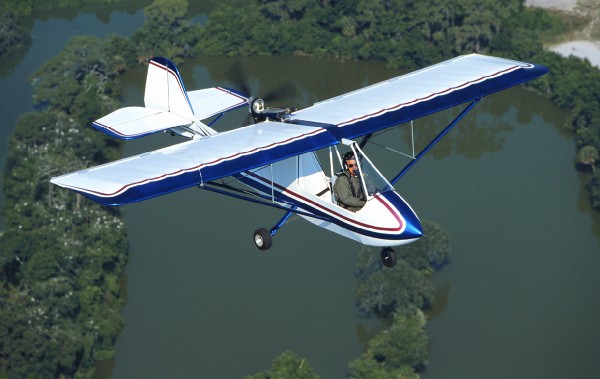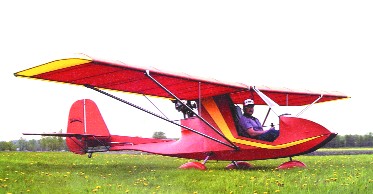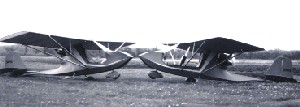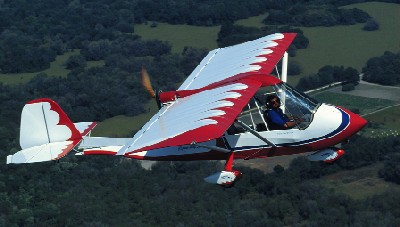

Dave Goulet poses with one of the original Challengers first introduced in 1983. The bright orange and yellow ultralight was the standard bearer for Quad City Ultralight Aircraft Corporation in its early years. (Photo by Hal Adkins, courtesy Quad City Ultralight Aircraft Corp.)

In 1984, Quad City introduced their two-place trainer, which also qualified as a 51-percent homebuilt kit. Here the single-seat and two-seat version sit nose to nose for size comparison. (Jerry McGinnis)

With over 2,500 aircraft kits shipped, there are Challengers of every color flying throughout the United States. Privately owned Challengers have garnered a number of awards at fly-ins around the country, including, right, Steve Lee’s green and white clipped-wing Challenger II and Ben Dawson’s Clipped-Wing Special, above, both of which were named Grand Champion aircraft at Sun ‘n Fun in years past.


Here’s how the Challenger II fuselage is shipped to builders.. well, okay, the seat cushion isn’t already in place. The father and son team of Quent and Mark Gerlach of Oshkosh, Wisconsin, who are currently assembling this Challenger II, just couldn’t wait to sit inside and start making airplane noises!

The standard-wing Challenger II, shown here, has a wingspan of 31.5 feet versus 26 feet for the clipped-wing version. Total wing area for the standard wing is 173 feet versus 143 for the clipped-wing. While Dacron was used to cover the wings of early-day Challengers, most builders today choose one of the standard aircraft covering processes such as Poly-Fiber or Superflite.

Skis and floats are popular on Challenger aircraft; offering year round flying in northern areas, especially Canada, and adding versatility to fair weather flying as well.
“I started the company in 1983, and I still own it,” reports Dave Goulet, the main man behind the Challenger aircraft design and Quad City Ultralight Aircraft Corporation. “In fact,” he adds, “it’s probably the oldest ultralight company still under the same management. “After reviewing all the ultralight companies I can think of, I’m inclined to agree.”
Thinking of other long-term operations, Goulet mentions The New Kolb Aircraft Company, whose roots are also planted deep, but even that storied company has now changed ownership… twice in the last decade, and most recently just a couple years ago.
Quicksilver Mfg. has been around longer, but the revolving door of managers and several changes of ownership have long since taken that familiar brand out of contention for continuous leadership.
About the only challenge to Challenger’s continuity reign that I can think of would be Chuck Slusarczyk, designer of the Hawk series, and his company, CGS Aviation. However, even Chuck dabbled with outside ownership and management back a decade or so ago. That leaves Goulet standing tall as the person holding the reins for the longest continuous operation of an ultralight aircraft company.
One thing is certain: The Challenger design has been an unqualified success any way you look at it. They’ve sold well for years, and they still sell well.
Old and Successful
The ultralight industry isn’t known for the longevity of its companies. When I wrote a piece about the industry in 2000, I researched back to 1975, tracing the lineage of ultralights back to the earliest names like John Moody, Larry Newman, Lyle Byrum, Homer Kolb, Jack McCornack, and other ancient luminaries of this tiny industry.
Certainly a few names got to the party ahead of Goulet’s Quad City Ultralight Aircraft Corporation, yet the greater measure may be sustained success. The Challenger is now beyond 2,500 units delivered. They say, and I concur, that their brand is one of a very few to achieve such market stature.
Some folks tease the company about its distinctive ad, which has not changed for better than a decade. “How can they never change their ad and never change their plane and still sell so many?” is a lament I’ve heard from several prominent manufacturers in the ultralight/light plane industry. The truth is, change has been a part of Quad City Ultralights, even though a casual glance might seem to suggest otherwise.
Constant and Never Ending Improvement (CANI)
Years ago, I learned from then-owner Phil Reed of SkyStar Aircraft of a product development method called CANI, or constant and never-ending improvement. Especially in this age of high-speed Internet life cycles, companies can’t produce the same aircraft year after year.
But hasn’t the Challenger design stayed almost the same since it began, people counter. Well, if you don’t look closely, the question sounds valid. A child grows so gradually that a parent may not notice the change, but an infrequent visitor can be struck with what seem to be dramatic differences. Likewise, the Challenger design has actually undergone dozens and dozens of changes, some big, some minor; perhaps we just haven’t noticed. This is actually a story of persistence and the refinement of a design.
From virtually day one of Challenger production, the company has made several changes per year to improve the overall quality and durability of their airframe. Quad City Ultralights also made periodic changes to the control linkage, with the goal of bettering the aircraft’s handling.
For example, in 1985 the aileron bell crank was changed so pilots could adjust for more aggressive response. A year later a similar change was made for the same reason on the rudder.
In 1987, the elevator shape was transformed to incorporate a curved trailing edge that designers felt improved the aesthetics, but it made very little change in the design’s flying characteristics. Later, the factory added a choice in wing coverings, from sewn Dacron sails to certificated aircraft fabric, to increase durability (some owners also feel painted surfaces improve performance and handling).
By 1988 optional streamlined struts and gear fairings became available. These two changes alone were said to measurably improve the sink-rate performance of Challengers. 1988 was also the year a clipped-wing single-seater was offered, resulting in further improvements in performance and handling by using higher wing loadings.
Shortly after, a clipped-wing version of the two-seater broadened the product line, although for years the models going to Canada had slightly greater spans to meet regulations in that country. By 1996 the span of the Canadian-export was reduced from 28 feet to 26 feet to be consistent with other models shipped around the world. (A change in Canadian regulations eliminated the previous wing-loading minimum that necessitated the longer wing.)
Powering the Challengers
Since Quad City Ultralights put their first KFM-powered single-seater into production in 1983, the company has changed recommended powerplants several times. The KFM engine was dropped in 1984 when the Rotax 447-powered Challenger II entered production.
In those early days Quad City Ultralights used Rotax engines but employed a Hegar belt reduction drive unit rather than the gear drives so common today. Sport flying enthusiasts with enough history to remember those reduction drives may also recall that mufflers on those mid-1980s ultralight engines were a constant source of problems. Indeed, in 1985, Quad City introduced their own stainless steel, wraparound exhaust mount for the Rotax. In that same year the company also added optional long-range fuel tanks totaling 10 gallons, a function of larger, more powerful engines that demanded more fuel.
By 1986 Quad City Ultralights developed a mount to permit the higher horsepower Rotax 503 to be used as an option. With bigger engines came more difficult starting, hence the addition of an electric starter in 1988. However, the Challengers of those days could not use the Rotax-brand electric starter, so the company developed their own built around the ADS system.
Many ultralight pilots who entered the sport in the early 1990s remember that Hirth engines were a common sight on Challenger aircraft, too, as the company included the Hirth 2703 model as an alternative to the Rotax 503.
Despite the interest in Hirth, Quad City Ultralights focused on the Rotax 503 when the long-awaited aircraft version was introduced in 1990 with many refinements over the earlier snowmobile-derived engine. Given Rotax’s then-new thrust into the aviation marketplace, it’s no surprise that Quad City Ultralights ended up with the Rotax brand powering most of their aircraft. Nonetheless, the company supported Hirth engines for several more years. In fact, in 1991 Hirth also came out with a dual electronic ignition system that helped the brand compete with Rotax.
By then, Quad City Ultralights was able to drop the ADS starter and replace it with the Rotax brand that customers favored. In the later 1990s, Quad City Ultralights solidified Rotax engines as the powerplant(s) of choice and made minor changes in reduction drive gear ratios and prop size to gain a 10-mph increase in speed and a commensurate increase in climb rate.
Increasing Sophistication
While engines are very important to pilots, so are creature comforts. Only one year after the first Challenger single-seat aircraft went into production, the Moline, Illinois, company added fabric and Lexan doors to increase comfort.
With a very strong Canadian distributor, National Ultralights Inc., selling lots of aircraft in Canada’s cold climate, protection from wintertime flying became a frequent buyer request. In 1986 Quad City introduced an optional winter enclosure comprising a wraparound windshield and a pair of removable doors. A couple of years later the simpler system for the single-seat models was improved to a wraparound enclosure. That same year the fuselage shape was changed, partly to facilitate spark plug access but also to provide room for a cabin-adjustable heater system.
In 1989 optional smoked glass and tinted windshield and winter enclosures were offered to customers to decrease summertime cabin temperatures. Canada may be cold in winter, but the temperatures warm up generously in the summer months. Plus, many Challenger ultralights were being sold in the sunny southern United States. That same year fiberglass droop wingtips were added as a cosmetic option, and Challenger ultralights so equipped won awards at air shows that year. By 1992 an optional three-piece fiberglass gap cover created a smoother, more attractive fairing over the junction of the windshield and the wing and helped reduce drag at the prop hub. The year before, a more pointed fiberglass nose fairing became an option for the two-seater, and in 1993 the same option was offered for the single-seater.
It wasn’t until 1997 that a different pair of fiberglass wingtips was introduced. Ironically these were shorter, just 6 inches beyond the end of the spar versus 18 inches for the older tips. This cut the design’s wingspan by 2 feet, which bumped up cruise and top speed, better meeting the cross-country desires of some Challenger buyers. The resulting stiffer wing was also said to improve the roll rate.
In 1998 Quad City Ultralights replaced their two-piece seat cushions with a one-piece design, as a few rear seat-back cushions had been blown out of the plane, sometimes going through the prop. Over the years, new seat designs have created a more spacious cabin for both pilot and passenger. As the new millennium started, the Challenger windshield and enclosure were upgraded from a 0.04- to 0.06-inch thickness in both clear and tinted versions.
Other user-friendly additions over the 18 years of Challenger development include main wheel brakes first added in 1985. Four years later, the company supplied brakes pre-welded to the axles to simplify assembly, one of a long chain of efforts to make the homebuilder’s job easier.
In 1985 Quad City Ultralights followed general aviation tradition by bringing out their first airspeed indicators with color-coding to show the green, yellow, and red arcs that are appropriate to Challenger operation. The next year they introduced flaperons to the design, which were said to reduce stall speed by 5 mph. They also doubled as an in-flight trim adjustment. In those days, both features were quite rare.
Optional Mylar-coated wing sails-built using pre-sewn Dacron construction-gave greater service life, added slightly to speed, and yielded an attractive, shiny appearance.
Since ultralights work so well on floats, the 1995 addition of Puddlejumper floats in amphibious form gave the Challengers a slick way for pilots to fly from water or land.
Why Buy a Challenger?
The king of Challenger sales is National Ultralight Inc., owned by Ian Coristine and his partner Bryan Quickmire, with their company accounting for an amazing 400 units sold in Canada alone. That’s about one out of every six Challengers ever built! The two partners have a keen idea of why their sales are so strong. “By remaining focused on a single design, rather than constantly introducing new models for marketing hype, the Challenger has been refined to a much greater degree of performance and reliability,” writes National Ultralight Inc., on their info-heavy website: www.Challenger.ca.
In the area of performance, they state, “the Challenger has one of the widest speed envelopes of any recreational airplane.” It manages to meet the designer’s holy grail of a 4-to-1 speed range differential, operating from 24 mph to 96 mph (for the single-place, long-wing model).
The buy-and-fly crowd-who tolerate building only to get what they want-love the Challenger’s built-by-the-factory airframe. It isn’t fully built, of course, needing to meet the 51-percent rule for those not flying under Part 103’s trainer exemption. But the major components of the airframe-fuselage, wings, and tail-are manufactured at the factory prior to shipment.
National Ultralight’s Coristine explains, “Jigs are used extensively to insure accurate alignment during the construction process. This kind of precision would be very difficult to accomplish by homebuilders.”
Quickmire and Coristine tick off a number of their favorite purchase points: “All Challengers are effectively quick-build kits. The factory (does) all the important and demanding structural work, including installing the controls. “Most companies charge an extra fee (up to several thousand dollars) for their quick-build option.
“First timers usually take less than 300 hours to complete the assembly, covering, and painting. The fastest time on record is 172 hours, with the average being 225 to 275 hours,” say the two partners.
Once your Challenger has been completed, it only takes a half hour or so to remove or reinstall the wings for storage or trailering.
Quick-build kits for the two-seat Challenger II on wheels, including the engine and all covering materials except paint, range from $12,500 to $16,500. Most other manufacturers publish price lists that exclude the engine as well as the 40 percent to 70 percent premium charged for quick-build versions, if available!
“You can have your Challenger assembled, covered, and painted for as little as $6,000 Canadian ($3,825 American, at current exchange rates). “This is legal under Canadian rules and permissible for an aircraft that qualifies under Part 103 or the exemption. Those on a budget may purchase a series of subkits-tail, wings, fuselage, and engine-paying for them as possible.
National Ultralight boasts that the most popular floats and skis used on Challengers are made in Canada. Puddlejumper amphibious floats are priced at $5,400 Canadian ($3,450 American), while snow skis are $800 to $1,150 ($500 to $750 American) depending on the type.
“The International Challenger Owners Association (ICOA), with 800 members worldwide, will put you in touch with other owners,” claim Coristine and Quickmire. Three hundred members are in Canada alone.
Right Then, Right Now?
Almost no ultralight enthusiast would deny the Challenger is one of the standard bearers in the industry. Given the difficulty faced by many suppliers, Dave Goulet and Quad City Ultralight Aircraft have every right to be proud of their achievements over the years.
Even financial officer Bill Ehlers expressed pride in having been Goulet’s associate since 1983. He doesn’t fly and hasn’t been up in the aircraft for many years, but the satisfaction in his voice is obvious. Goulet, Ehlers, other principals over the years, and the entire staff can rightly sport a smile and the dignity of a job well done. The numbers speak for themselves.
“Today, over 2,500 airplanes and 100 design changes later, the new Challenger is significantly more capable,” expresses Coristine.
In November of 1996 Quad City Ultralights shipped their 2,000th Challenger. They believe that only two other companies have ever reached this level of volume, and then only by offering several models that combine to reach this number of units.
As a longtime veteran of this industry, I’m glad Quad City Ultralights remains successful. Companies like this create many happy pilots who have a bounce in their step as they make their way to the airpark for a little joy in the air aboard their Challenger.
| Seating | 2, tandem |
| Empty weight | 320 pounds/360 pounds 1 |
| Gross weight | 800 pounds/850 pounds |
| Wingspan | 31.5 feet/26.0 feet |
| Wing area | 173 square feet/143 square feet |
| Wing loading | 4.6/5.9 pounds/square foot |
| Useful Load | 480 pounds |
| Length | 20 feet, both models |
| Payload (with full fuel) | 420 pounds |
| Height | 6 feet, both models |
| Fuel Capacity | 10 gallons |
| Notes: | 1 The first set of numbers is for the long-wing Challenger II Trainer, the second set is for the clipped-wing Challenger II Special. |
| Standard engine | Rotax 503 Dual Carb 1 |
| Power | 52-hp |
| Power loading | 12.1 pounds/hp |
| Max Speed | 100 mph |
| Cruise speed | 70 mph |
| Stall Speed | 33 mph |
| Rate of climb at gross | 900 fpm |
| Takeoff distance at gross | 200 feet |
| Landing distance at gross | 200 feet |
| Notes: | 1 Performance specs as tested for the Challenger II Trainer. Standard engine is Rotax 447 (40-hp). |


I was thinking of finding more information of the Challenger float plane to buy. First off, are you still in business? If not, I might buy a used one, but can I still get parts for the plane? I tried calling. Can you leave me a good number? Oh, and how to call from the U.S? Thanks so much!!!
Hi Lee: I am not sure someone at Quad City will see your message here but try contacting them directly. This is an American company, so I don’t know what to say about your question about calling from the U.S.